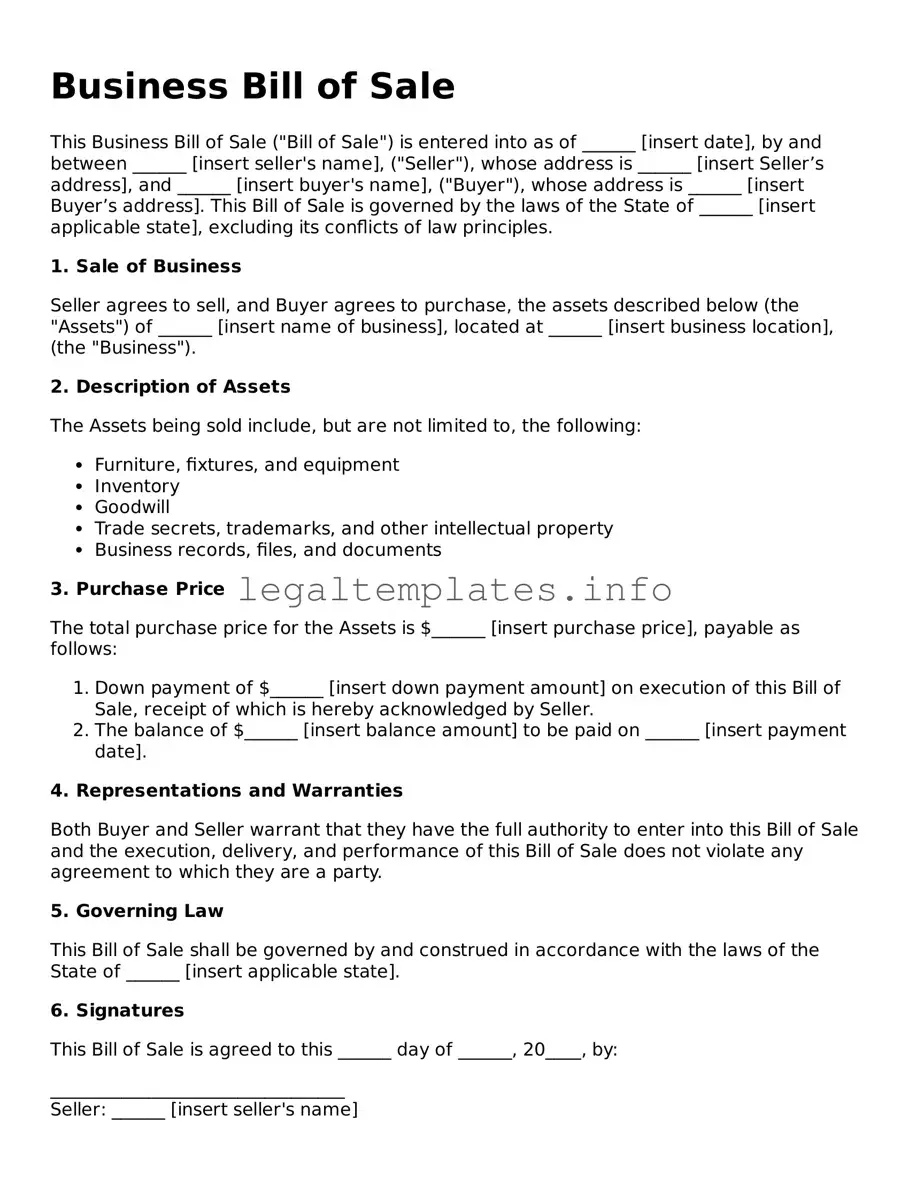The Business Bill of Sale form shares similarities with the Asset Purchase Agreement, as both are used in the context of a sale and purchase transaction. However, an Asset Purchase Agreement is broader, detailing the sale and transfer of assets from one business to another, including tangible and intangible assets, liabilities, and sometimes even employees. The Business Bill of Sale is typically focused on the transfer of ownership for specific assets, serving as a receipt for the transaction.
Similar to the Warranty Deed in real estate transactions, the Business Bill of Sale provides assurances from the seller to the buyer regarding the ownership and status of the assets being sold. While a Warranty Deed guarantees clear title to real property, affirming there are no liens or encumbrances, the Business Bill of Sale reassures the buyer of the legitimate transfer of ownership for personal or business property, free from any undisclosed liabilities.
The Quitclaim Deed is another document that echoes the purpose of the Business Bill of Sale, but in the realm of real estate. Unlike the Business Bill of Sale, which transfers ownership of business assets with a guarantee of clear title, the Quitclaim Deed transfers property rights with no guarantees—simply transferring whatever interest the seller has in the property, if any. Both documents finalize the transfer of property, albeit with different levels of seller liability.
The Bill of Sale form, for personal property, is akin to the Business Bill of Sale but on a smaller scale. While the former often pertains to the sale of individual items, like a car or a boat, the latter encompasses a broader range of assets, potentially including an entire business. Both serve as legal evidence of a transaction, detailing the goods sold, the sale price, and the parties involved, providing proof of transfer and receipt of payment.
A Promissory Note also shares commonalities with the Business Bill of Sale, as both are integral in transactions involving valuable considerations. However, the Promissory Note is essentially a financial instrument, representing a written promise by one party to pay another a definite sum of money either on demand or at a future date. While the Business Bill of Sale confirms the transfer of goods or business assets, a Promissory Note involves the commitment to pay, thus facilitating transactions that may not be immediate cash exchanges.
The General Agreement is another document closely related to the Business Bill of Sale, as it can encompass various aspects of a business transaction. This document outlines the terms and conditions agreed upon by two parties, potentially including the sale of business assets. However, the General Agreement is more versatile, covering a range of agreements beyond the sale of assets, such as partnerships, nondisclosure terms, and more, making it broader in scope but less specific in function.
Like the Business Bill of Sale, the Sales and Purchase Agreement (SPA) is used in transactions involving the sale of goods or assets. However, the SPA is more comprehensive, often including detailed terms of the sale, warranties, indemnities, dispute resolution mechanisms, and conditions precedent that must be satisfied before the transaction can complete. It is applicable in both the sale of individual assets and whole businesses, making it a more detailed contract that governs the entirety of the transaction process.
A Receipt, in its most basic form, is similar to the Business Bill of Sale as it acknowledges the receipt of payment and serves as proof of a transaction. However, a Receipt is generally more simplistic, providing minimal details such as the amount paid and the date of payment. In contrast, the Business Bill of Sale contains more detailed information regarding the assets being transferred, the parties to the transaction, and any warranties or representations made by the seller.
The Loan Agreement shares a transactional kinship with the Business Bill of Sale but focuses on the terms under which one party lends money to another. The Loan Agreement details interest rates, repayment schedules, and the consequences of default, making it crucial for borrowing and lending money. Unlike the Business Bill of Sale, which finalizes the transfer of ownership for assets, a Loan Agreement governs the conditions under which financial assets are temporarily transferred.
Finally, an Employment Contract, while primarily focused on the conditions of employment between an employer and an employee, can occasionally intersect with the purposes of the Business Bill of Sale during business acquisition scenarios. It outlines roles, responsibilities, compensation, and confidentiality agreements but may require adjustments or renewals in the event of a business sale, especially if the business's assets, including contracts with key employees, are part of the sale. This demonstrates how even documents centered on human resources can relate to the transfer of business ownership.
